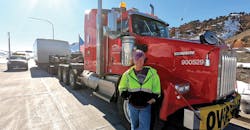Editor’s note: This is the first part in a series on women working in the trucking and how fleets are welcoming them to the industry.
When Ingrid Brown started driving a truck in 1979, it was rare for her to see another woman on the road. Back then, the owner-operator knew of six other female drivers who ran a regular route from North Carolina to California, and they would leave handwritten notes for each other at truck stops.
“We didn’t have cell phones, but we kept in touch with each other. There was a bond,” said Brown, who drives for Rabbit River, based in Holland, MI.
Today, Brown sees more female counterparts on the road, and social media makes it easier to stay in touch. Yet research from the Mineta Transportation Institute (MTI) shows that while women account for 50% of the working population, the transportation industry attracts less than 15% of the female workforce.
“In the past, women didn’t think about it. Women have to see other women doing it before they start thinking about it,” said Ellen Voie, founder of the Women In Trucking Association (WIT).
That is why flatbed fleet Lone Star Transportation encourages women to share their experiences. “It gives other female drivers the confidence they can do it too,” said Kristi Williams, chief financial officer for the Fort Worth, TX-based carrier.
Lone Star has emphasized outreach to women as part of its social media strategy. It has created a “women in trucking” page on its website and produced a YouTube video featuring a female driver.
“We found that to attract the female drivers, no one could do that better than the women who are already here,” said Williams.
Peterbilt Motors Co. also does outreach through the Peterbilt Women Initiative, an advocacy group comprised of employees who come together to inspire and empower women, said Tina Albert, co-chair of the initiative and an assistant plant manager.
“We need to change women’s perception of the transportation industry to be more attractive to female candidates. Women need to know how exciting the industry is and how much pride can come from contributing to such an important sector of our economy,” Albert explained.
Treana Moniz, a driver for Bison Transport, has noticed a change since she started driving 12 years ago. “What was once just a male occupation is now becoming more and more versatile,” she said. “The trucking industry is so wide there are opportunities for anyone.”
That includes driving, safety positions, mechanics and back-office work.
Josephine Berisha, senior vice president of compensation and benefits for XPO Logistics, said the company is seeing double-digit increases in the number of women joining its logistics business and single-digit increases on the less-than-truckload side.
One area of the warehouse where XPO is seeing women excel is in operating forklifts. “These are some of the higher paying hourly jobs in the warehouse, and our female-powered industrial truck operators are being promoted rapidly,” Berisha said.
Editor’s note: This is the first part in a series on women working in the trucking. In Part 2, we’ll look at how women drivers make fleets safer.

